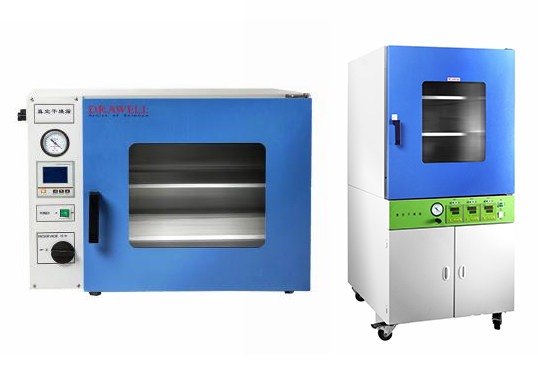How to Select the Right Vacuum Drying Oven
Vacuum drying ovens are indispensable in laboratories and industrial environments, providing efficient drying while minimizing the risk of damaging sensitive materials. Selecting the right vacuum drying oven involves addressing several crucial questions to ensure optimal performance and safety. Whether you're a seasoned researcher or new to vacuum drying, understanding key factors will help you make an informed decision.

In this article, we'll explore the essential questions to consider when choosing a vacuum drying oven, focusing on aspects such as size, temperature range, required vacuum level, and suitable materials for drying.
1. What Size Vacuum Drying Oven Do I Need?
Determining the appropriate size for a vacuum drying oven depends on your specific requirements and the volume of materials you plan to dry. Consider the following factors:
Sample Volume: Assess the quantity of materials to be dried in a single batch. Large samples or significant volumes require a larger oven.
Available Space: Ensure the oven fits comfortably in your laboratory or workspace without obstructing other equipment or workstations.
Sample Size and Shape: The oven's chamber dimensions should accommodate your largest samples without crowding.
Throughput and Efficiency: For high sample volumes needing frequent drying, a larger oven with faster processing capabilities improves efficiency.
Future Needs: Anticipate potential increases in workload. An oven with extra capacity may be beneficial for future expansion.
Budget: Larger ovens typically cost more. Balance your budget with your requirements to find the most suitable size.
List the typical sizes and quantities of samples you'll be working with and consult with laboratory equipment suppliers or manufacturers to discuss your specific requirements. They can recommend an oven size that best suits your needs.
2. What Temperature Range Does a Vacuum Drying Oven Need to Maintain?
The temperature range required for a vacuum drying oven varies depending on the application and materials being dried. Generally, vacuum drying ovens offer precise temperature control, typically ranging from ambient temperature to around 200-250°C (392-482°F).
Low-Temperature Range: Operating from room temperature (20°C or 68°F) to 100°C (212°F), suitable for heat-sensitive materials that degrade at higher temperatures.
Medium-Temperature Range: Spanning from 100°C (212°F) to 150°C (302°F), covering a wide variety of materials for general drying applications.
High-Temperature Range: Reaching 150°C (302°F) to 200°C (392°F) or higher, suitable for materials requiring elevated temperatures.
Ultra-High-Temperature Range: Specialized ovens for specific industrial applications may reach up to 250°C (482°F) or more.
Choose a vacuum drying oven with a temperature range that matches your specific needs. Ensure accurate and reliable temperature control, especially for temperature-sensitive materials. Always follow the manufacturer's guidelines for operating within the specified temperature range.

3. What Level of Vacuum Does a Vacuum Drying Oven Need to Achieve?
The required vacuum level depends on the materials being dried and the drying process. Vacuum drying ovens can achieve various vacuum pressure ranges, typically measured in millibars (mbar) or torr:
Low Vacuum: 200 to 400 mbar (150 to 300 torr)
Medium Vacuum: 10 to 100 mbar (10 to 75 torr)
High Vacuum: 0.1 to 10 mbar (0.1 to 7.5 torr)
The specific vacuum pressure needed varies based on the materials and desired drying conditions. For heat-sensitive or volatile materials, a higher vacuum level may be necessary to minimize degradation or loss of volatile compounds. Some materials may require a lower vacuum level for efficient drying without damage.
Consider the vapor pressure of the substances you are drying and choose an oven that can achieve the required vacuum level for your application. Manufacturers typically provide information on their ovens' vacuum pressure capabilities.
4. What Type of Material Can I Dry in a Vacuum Drying Oven?
Vacuum drying ovens are versatile and can dry a wide range of materials across various industries. The controlled temperature and reduced pressure make them suitable for drying heat-sensitive, delicate, or volatile substances:
Heat-Sensitive Materials: Pharmaceuticals, chemicals, and biological samples that degrade at higher temperatures.
Organic Solvents: Gentle drying of low boiling point solvents to prevent excessive loss or unwanted reactions.
Pharmaceuticals and Intermediates: Drying products containing active pharmaceutical ingredients (APIs) without compromising integrity.
Laboratory Glassware: Ensuring completely dry surfaces, crucial for accurate measurements and precise experiments.
Electronic Components: Removing moisture to prevent potential damage during further processing or assembly.
Food Products: Drying fruits, vegetables, herbs, and other items while preserving color, flavor, and nutritional content.
Chemicals and Reagents: Effective for drying various chemicals, reagents, and mixtures.
Polymers and Plastics: Removing moisture before processing or molding to improve product quality.
Catalysts and Precursors: Enhancing stability and catalytic activity by drying in a vacuum oven.
Not all materials are suitable for vacuum drying, especially those that may react with reduced pressure. Verify compatibility and follow recommended procedures for safe and effective drying. Consult the manufacturer’s guidelines for appropriate drying conditions.
Conclusion
Selecting the ideal vacuum drying oven involves careful consideration of various factors to match your specific applications. From the oven size and temperature range to the vacuum level and suitable materials, each aspect plays a critical role in its effectiveness and efficiency. Prioritize safety by adhering to the manufacturer’s guidelines, ensuring proper maintenance, and using appropriate protective gear. By addressing the essential questions highlighted in this article, you can confidently make an informed choice and invest in a vacuum drying oven that meets your research or industrial needs, delivering reliable and precise results.
- Art
- Causes
- Crafts
- Dance
- Drinks
- Film
- Fitness
- Food
- Games
- Gardening
- Health
- Home
- Literature
- Music
- Networking
- Other
- Party
- Religion
- Shopping
- Sports
- Theater
- Wellness


